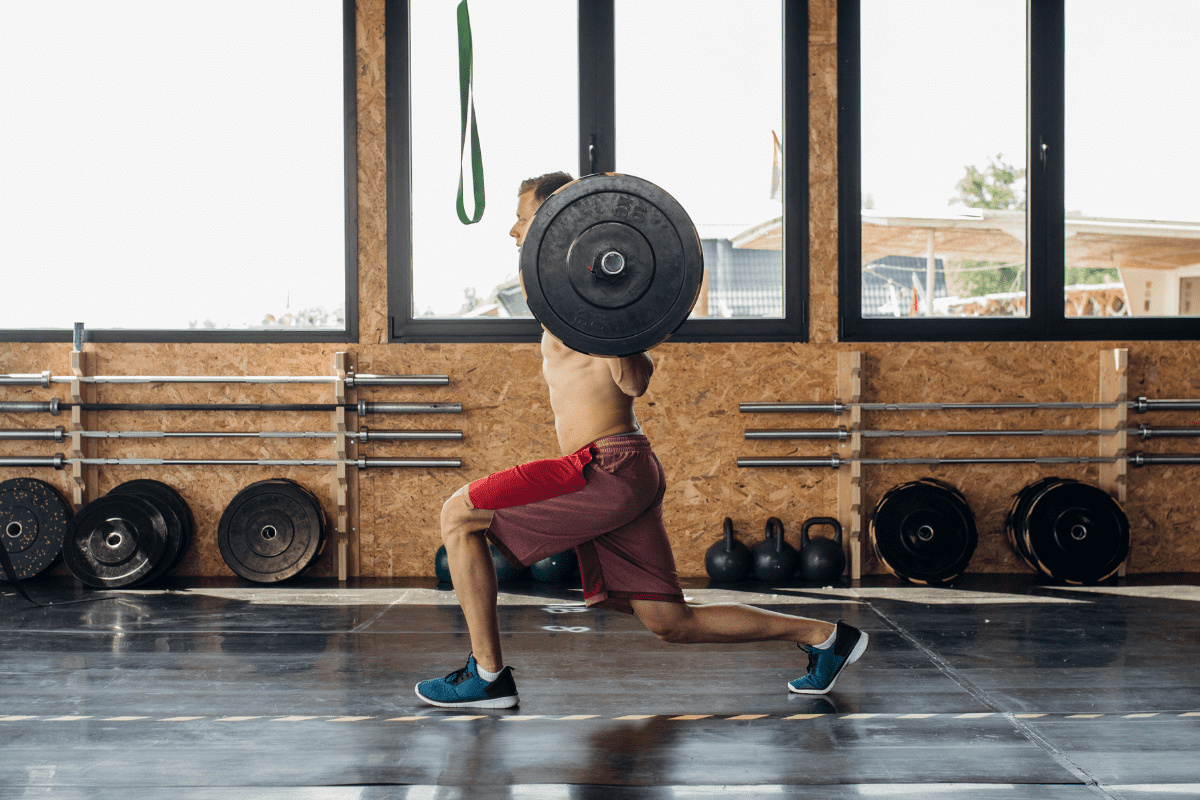9 Barbell Lunge Alternatives For Single Leg Strength
The Barbell Lunge is a classic lower-body exercise that targets the muscles in the legs and glutes. It is a great way to build strength and improve mobility, but it may not be suitable for everyone, especially those with certain injuries, knee pain or other limitations.
In this article, I will explore a variety of lunge alternatives that can help you achieve similar benefits and work the same muscles as the Barbell Lunge.
Whether you are looking for a low-impact option, or just want to mix things up in your workout routine, I’ve got you covered.
Best Barbell Lunge Alternatives
I tried to include as much variety as possible within this list of alternatives. There are exercises that utilize a wide variety of equipment – barbells, dumbbells and no equipment at all!
I’ve also included beginner-friendly exercises and some more appropriate for advanced lifters.
What all these lunge alternatives have in common though is that they are all single-leg movements that will work basically the same muscles.
My goal is that no matter what equipment you have access to or what your level of experience is, at least one of these exercises will fit exactly what you need.
Pistol Squat
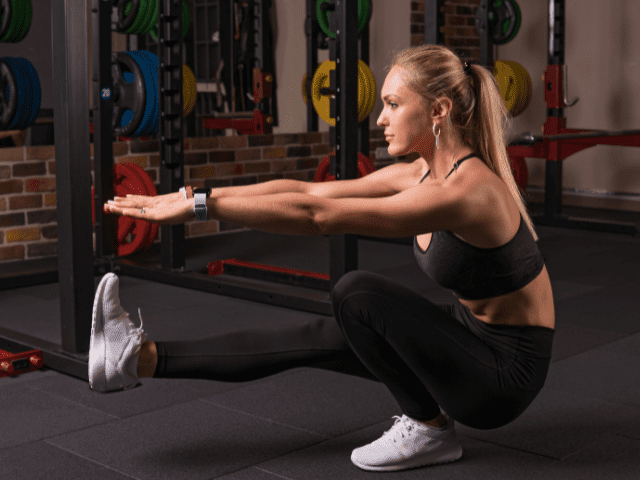
Pistol Squats are one of my favorite single-leg exercises and a great Barbell Lunge alternative.
It is a true single-leg movement – meaning the opposite leg does not contribute whatsoever as oftentimes happens with exercises like lunges or split squats.
It’s also easily modifiable. You don’t have to be able to drop all the way to the ground like in the pic above! You can start by squatting down to a bench and then driving yourself back up.
Equipment Needed
- None (If doing a modified Pistol Squat a box or bench to squat to will be needed)
Instructions
On Air
- Stand on one leg with the opposite leg straight and slightly out in front of the body.
- Squat down on the single leg by hinging back at the hips first and then bending the knee and hips until the crease of the hip crosses below the knee.
- Keep the heel flat and your weight distributed between your heel and mid-foot.
- Keep your torso as vertical as possible while maintaining balance and a flat foot.
- The opposite leg should stay straight and extend out in front of you as you squat down (tight hamstrings will make this almost impossible!)
- Once you reach the bottom of the squat, drive the foot through the floor and stand tall.
To Box
- Instructions are the same as above, except the athlete will squat down to a box (or bench) instead of freely in an open space.
- Make sure the foot is close enough to the box so that the box is not missed when squatting down to touch it. (I’ve seen it happen)
- Control the descent to the box and sit as softly as possible. A light touch-and-go is ideal if possible. My favorite cue for this was to “treat the box like a glass coffee table.”
Coaching Points
If you’re not able to do a Pistol Squat the first time trying, don’t worry, you’re not alone. Most athletes I’ve worked with have to start by using a bench for pistol squats. The first thing you need to do to start progressing is figuring out where your real weakness is: strength or flexibility.
Some lifters simply don’t possess the strength at first to perform a full pistol squat on air. On the other hand, many of the athletes I’ve coached actually have the strength to do a pistol squat, but they lack the mobility to be able to go through the full range of motion without falling or their opposite foot crashing into the ground.
Figuring out where to focus your energy is the first step toward improving your Pistol Squat.
Single Leg Squat off Box
Single Leg Squat off a box is another lunge alternative that doesn’t require any equipment at all to be effective.
In fact, if you’ve never tried Single Leg Squats off a box before you’ll probably be pretty surprised just how challenging this movement is.
Finally, like Pistol Squats, this is a true single-leg movement – no help from the opposite leg at all.
Equipment Needed
- An extremely stable box or bench
- A partner who will hold down the side of the box if needed as a counterweight.
Step-by-Step Instructions
- Stand tall with one leg down and the other straight drifting off the side of the box.
- Initiate the squat by hinging at the waist and bending at the knee simultaneously.
- Descend until the hip crease is just below the knee.
- Keep the heel flat and the center of mass over the mid-foot.
- Keep the torso as vertical as possible. Sometimes holding the arms straight out from here will help with balance and torso positioning.
- Once you reach depth, drive through the heel, keeping the foot flat, and stand tall.
Coaching Points
A Single Leg Squat off a Box is by far one of the most difficult variations of single-leg training. A proper progression needs to be followed in order to prepare the athlete for a movement like this.
Skater Squats
Skater Squat is very similar to a Pistol Squat, but instead of lifting the opposite leg in front of you, the back knee is dropped down to the floor. At first glance, this makes the movement look like a Reverse Lunge.
However, because the back foot doesn’t brace on the ground, the opposite leg doesn’t contribute to the movement. This places all the stress on the working leg – a great quality for a single-leg exercise.
Equipment Needed
- None
Instructions
- Squeeze the shoulder blades and engage the lats to create a stable back to help with bracing the upper body
- Step backward with one leg, but do not place the foot back down on the ground.
- Instead, keep the chest as upright as possible and drop the back knee until it lightly touches the ground.
- Now drive through the heel and midfoot of the front foot to drive yourself back up tall.
- Repeat on the opposite leg and alternate back and forth until all reps have been completed.
Coaching Points (Fixes to Common Mistakes)
Keep the front foot flat on the floor when in the lunge position. One of the most common mistakes is raising up onto the ball of the front foot.
If you’re not able to do Skater Squats with good form, switch to a regular Reverse Lunge until you’re ready to do Skater Squats with proper form.
Bulgarian Split Squat
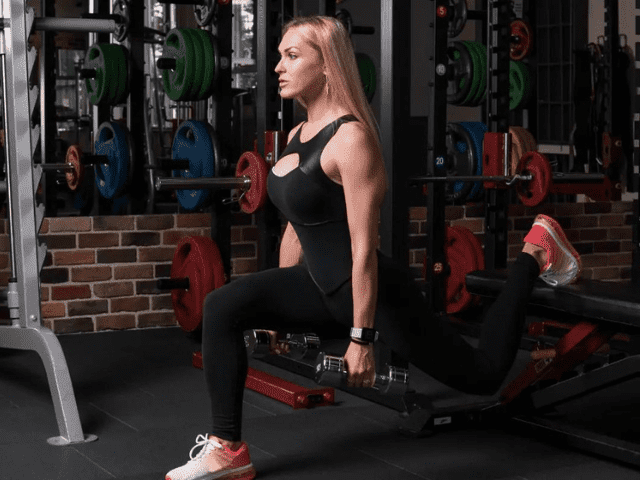
A Bulgarian Split Squat, also known as a Rear Foot Elevated Split Squat, is the last of the alternatives that is a true single-leg exercise. What I mean by that is the opposite leg is in a position where it can’t really help drive yourself back up.
Up to this point, every exercise has been literally on one leg. A Bulgarian Split Squat involves putting your back foot up on a bench so while it can help balance it can’t really do much work (which is the point).
Note: This exercise can also be done with a barbell, but dumbbells are much safer in the event you lose your balance during a set.
Equipment Needed
- Dumbbells
- Bench, Box or Stack of Bumper Plates (essentially anything stable enough and tall enough to place your foot on)
Instructions
- Grab two dumbbells, one in each hand
- Get set up in front of your bench, reach one foot back and place it on the bench. Make sure you feel comfortable and balanced before proceeding.
- Squeeze the shoulder blades and engage the lats to create a stable back to help with bracing the upper body and to keep the dumbbells from swinging unnecessarily.
- Keep the chest as upright as possible and drop the back knee to roughly one inch from the floor.
- Now drive through the heel and midfoot of the front foot to drive yourself back up tall.
- Repeat until all reps are completed on that leg and then switch sides.
Coaching Points (Fixes to Common Mistakes)
When you step out, make sure to keep the feet shoulder-width apart. If you’re feeling very off-balance in your lunge there is a good chance that you are placing the lead foot directly in front of the back foot (essentially placing yourself on a tight rope).
Barbell Reverse Lunge
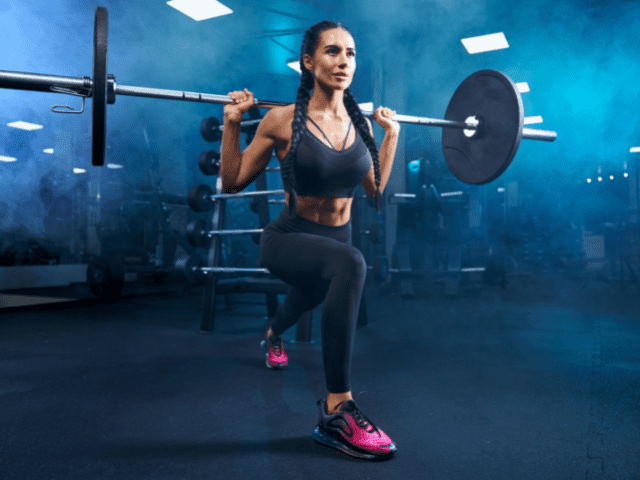
Barbell Reverse Lunge is a single-leg exercise that involves having both feet on the ground during the drive phase. This means you’ll have to be intentional with driving off the proper leg during the movement.
Many athletes I’ve worked with find that reverse lunges can be easier on the knees than forward lunges. This is mostly due to removing the forward momentum that can shift the weight of the lunge from the hips toward the front knee.
Equipment Needed
- Barbell
- Bumper Plates (Iron Plates are fine as long as you’re not dropping the bar between sets)
- Squat Rack (Not completely necessary as you can clean and press a bar onto shoulders if needed, but a rack is going to make this a whole lot easier, especially if lifting heavier weight)
Instructions
- Unrack the barbell similar to how you would unrack a bar for a back squat.
- Grab the bar with a slightly wider than shoulder-width grip.
- Squeeze the shoulder blades and engage the lats to create a stable shelf to sit the bar on
- Place the bar across the traps, brace the core and remove the bar from the rack by standing tall and then walking back out of the rack.
- Once you’ve created enough room for yourself from the rack you can begin the movement.
- Step backward with one leg, giving yourself enough room to be able to drop into a lunge comfortably without feeling overextended.
- Keep the chest as upright as possible and drop the back knee to roughly one inch from the floor.
- Now drive through the heel and midfoot of the front foot to drive yourself back up tall.
- Repeat on the opposite leg and alternate back and forth until all reps have been completed.
Coaching Points
When you step back, make sure to keep the feet shoulder-width apart. If you’re feeling very off-balance in your lunge there is a good chance that you are stepping the lead foot directly behind the front foot (essentially placing yourself on a tight rope).
Dumbbell Lunge
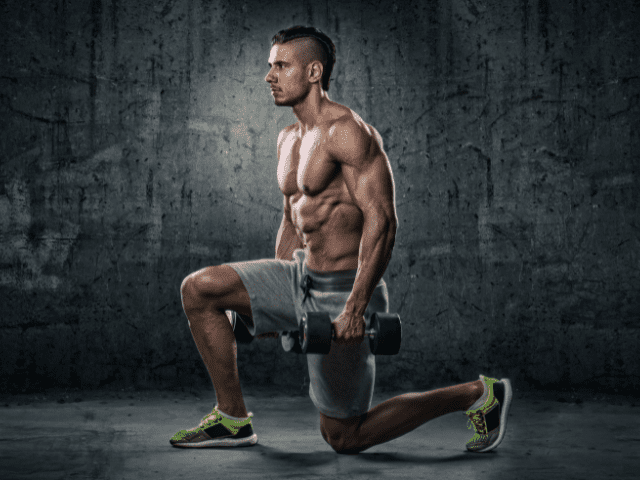
I’ve placed two lunge variations back to back here with Dumbbell Lunges and Barbell Reverse Lunges.
The truth is, you can use any variation you like the best. Lunge forward or backward. Or with a barbell or dumbbells. You can also lunge in place or do walking lunges across the gym.
Find the variation that works best for you or mix it up every few workouts.
Equipment Needed
- Dumbbells
Instructions
- Grab two dumbbells, one in each hand
- Squeeze the shoulder blades and engage the lats to create a stable back to help with bracing the upper body
- Once you’ve created enough room for yourself from the dumbbell rack (or wherever you pulled them from) you can begin the movement.
- Step forward with one leg, giving yourself enough room to be able to drop into a lunge comfortably without feeling overextended.
- Keep the chest as upright as possible and drop the back knee to roughly one inch from the floor.
- Now drive through the heel and midfoot of the front foot to drive yourself back up tall.
- Repeat on the opposite leg and alternate back and forth until all reps have been completed.
Coaching Points (Fixes to Common Mistakes)
When you step out, make sure to keep the feet shoulder-width apart. If you’re feeling very off-balance in your lunge there is a good chance that you are stepping the lead foot directly in front of the back foot (essentially placing yourself on a tight rope).
Dumbbell Step-Ups
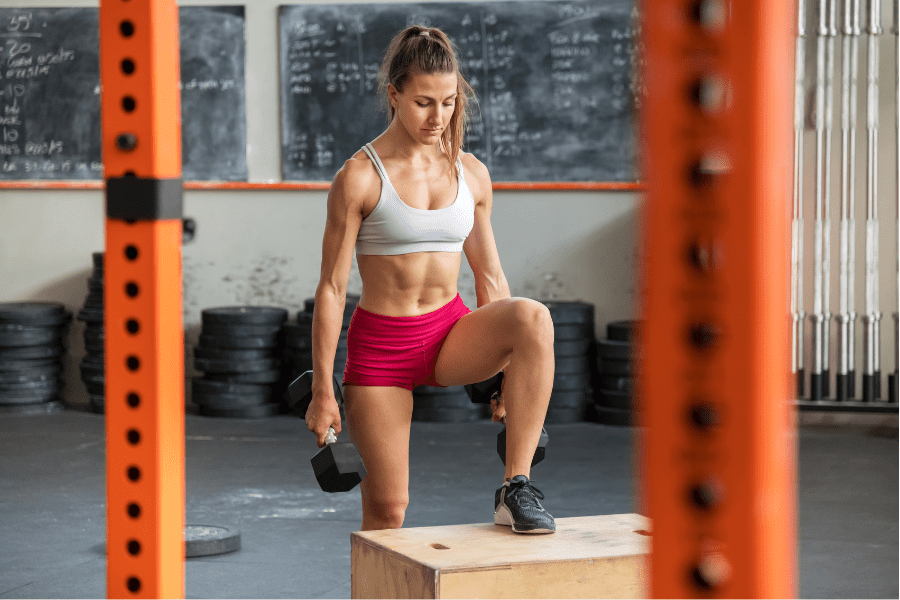
Dumbbell Step-Ups are another great single-leg exercise. You can modify both the difficulty and the quad or hamstring emphasis by how tall of a box you use. (taller box will hit the hamstrings more).
Like Lunges, Step-ups can be done with dumbbells or a barbell.
Equipment Needed
- Dumbbells (Kettlebells can also be used if needed)
- A very stable surface to step up to. (Ideally, a box or bench that is stable, heavy, and well balanced)
Step-by-Step Instruction
- With the dumbbells at your side, hinge at the waist and bend your knees to lift. Keep a neutral spine as you are lifting the dumbbells. NEVER ROUND YOUR BACK WHILE LIFTING.
- Use a box height that is going to allow your hip and knee flexion to be as similar as possible to your stride while sprinting or bounding.
- Place one foot on the box, and drive the other leg’s knee up.
- The leg drive should be fast and explosive. (Quick note: keep the up leg’s foot pulled up toward the shin).
- Engage the glutes and pause for a brief second at the top of the movement.
- Carefully lower the leg back down and prepare for the next repetition.
Coaching Points
A stable box cannot be overstated here. If the box is not stable, do not do step-ups. The risk-to-reward ratio should always be considered with all exercises and implements.
Box height is very important to benefit from this movement. If the box height is too short or high, there will be less sport or movement-specific training.
As with all movements, quality movement is better than quantity of weight. This movement is typically programmed for specific training of single-leg drive and down-leg stability. Make sure the knee drive is explosive.
If the dumbbells are getting in the way of your knee drive, hold the dumbbells in the front rack or goblet position.
Single Leg Leg Press
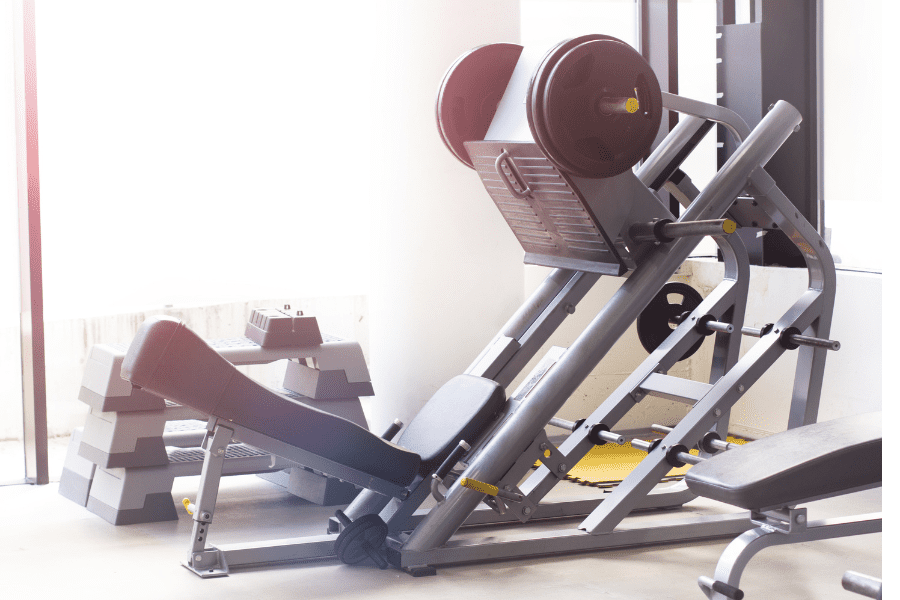
To be honest, I’m not a huge leg press machine fan. I believe there are countless other leg exercises that carry more benefits.
However, if an athlete has an injury to one leg that limits them in the weight room – this is a situation in which we’ll use the leg press machine for Single-Leg Leg Press.
How you’ll set up for Single-Leg Leg Press is very dependent on your specific machine. Leg Presses can vary quite a bit in how they’re set up and how they’re used.
What I will say is to start very light. Make sure you’re comfortable with the range of motion and comfortable with the amount of weight you’re using before you start increasing weight.
Prowler Push
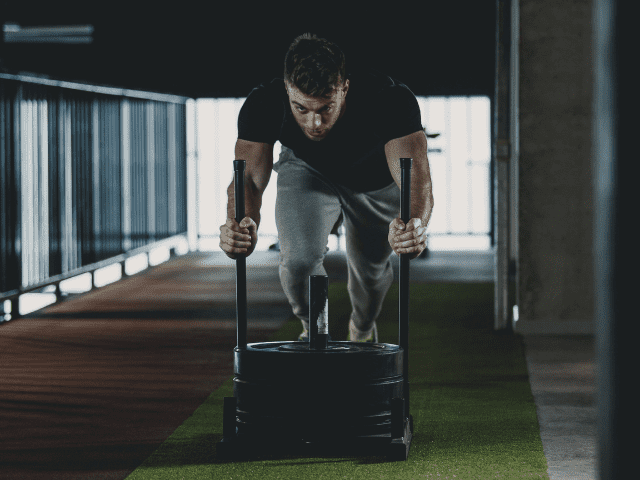
I wanted to finish off this list of Barbell Lunge alternatives with an exercise that is a little outside the box. Prowler Pushes are good for a lot of things, and one of those things is building single-leg strength.
If you load a prowler rather heavy and march forward with the Prowler, you will cook your legs fast and build a ton of strength in the process.
Equipment Needed
- Prowler sled
- Bumper or iron plates
- At least a 20-yard stretch of turf
- Proper footwear. Shoes with a good grip or cleats (if turf is available) are ideal.
Step-By-Step Instruction
- Set your prowler in an area where you can push it at least 20 yards without hitting anything.
- Load the prowler with weight.
- Get behind the prowler and grab the high handle position.
- Hinge at the waist, bend the knees and extend your arms.
- Drive your legs and push the sled forward.
Coaching Points
The prowler push is a full-body movement. Keep the core tight, nice neutral spine, and keep those arms extended (Arms can be bent when focusing on heavier loads).
Focus on a strong knee drive and pushing through your feet to keep the prowler moving. Your body angle will be very similar to how you start a sprint. So the lower body action should be very similar to running.
A very important consideration here is the surface you are pushing on. Ideally, you are pushing the prowler on turf. This gives enough surface tension so that the prowler doesn’t glide or get stuck too easily. If you are pushing on a slicker surface like concrete or carpet, you may have to load more weight on the sled.

Get Shredded… For Free
Get a free workout Monday through Friday, posted right here on Horton Barbell. These workouts are designed to help you get strong, in shape and look great at the beach!
Final Thoughts
The Barbell Lunge is a great exercise for strengthening the legs and improving balance, but it may not be suitable for everyone. If you have a knee injury or mobility issues, or if you simply want to try something different, there are several alternative exercises you can try.
I hope at least one of these alternatives I’ve listed here is a good fit for you and your training program.

